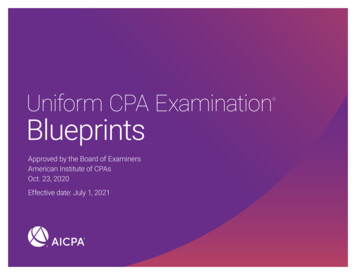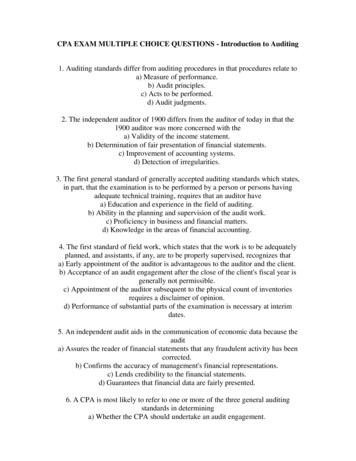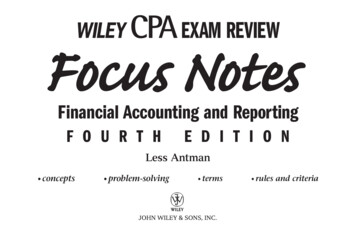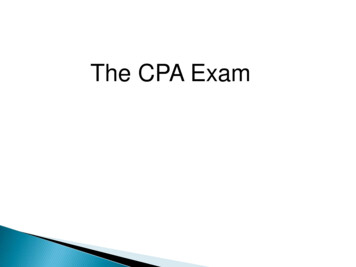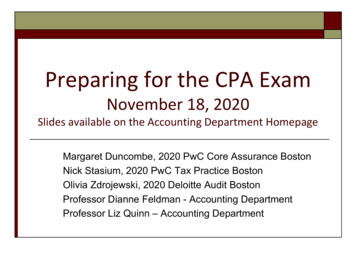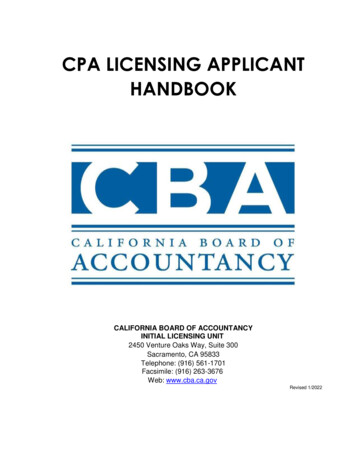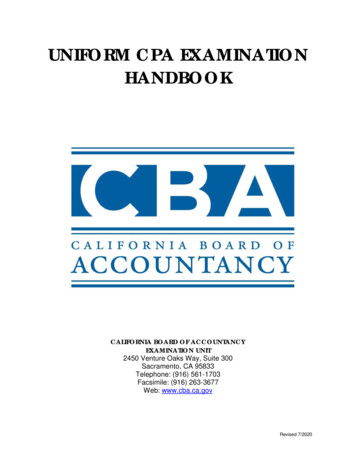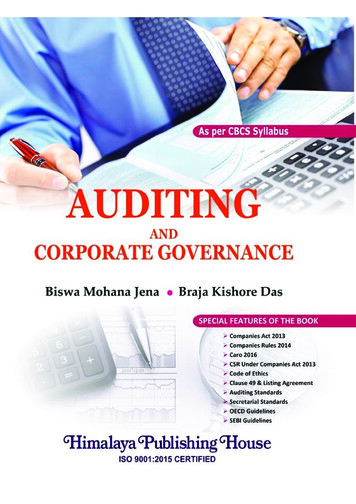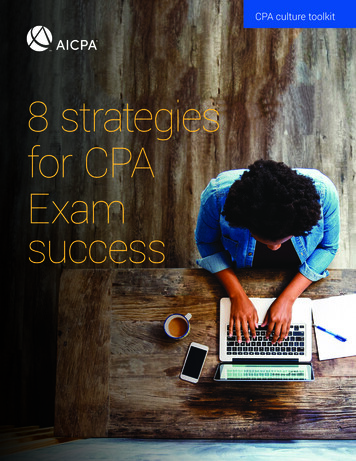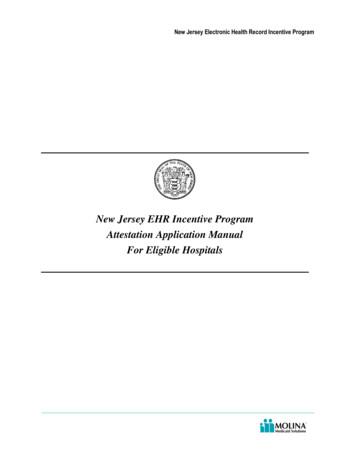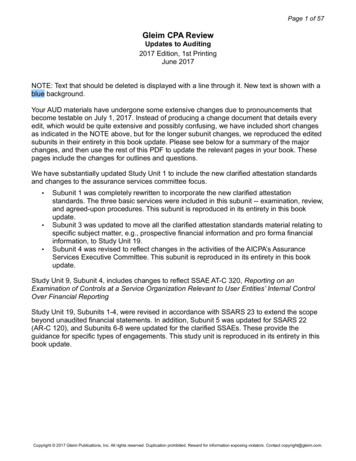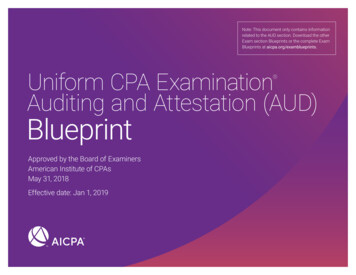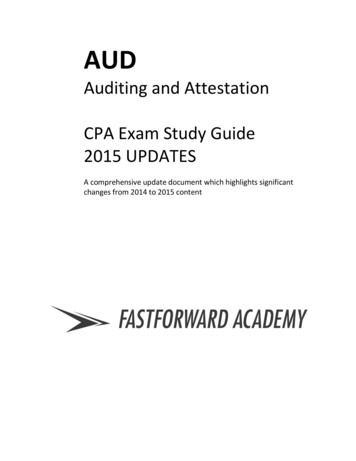
Transcription
AUDAuditing and AttestationCPA Exam Study Guide2015 UPDATESA comprehensive update document which highlights significantchanges from 2014 to 2015 content
Published by Fast Forward Academy, LLChttp://fastforwardacademy.com(888) 798-PASS (7277) 2015 Fast Forward Academy, LLC All rights reserved.No part of this publication may be reproduced or distributed in any form or by anymeans, or stored in a database or retrieval system, without the prior written permissionof the publisher.The information provided in this publication is for educational purposes only, and doesnot necessarily reflect all laws, rules, or regulations for the tax year covered. Thispublication is designed to provide accurate and authoritative information concerningthe subject matter covered, but it is sold with the understanding that the publisher isnot engaged in rendering legal, accounting, or other professional services. If legal adviceor other expert assistance is required, the services of a competent professional personshould be sought.To the extent any advice relating to a Federal tax issue is contained in thiscommunication, it was not written or intended to be used, and cannot be used, for thepurpose of (a) avoiding any tax related penalties that may be imposed on you or anyother person under the Internal Revenue Code, or (b) promoting, marketing orrecommending to another person any transaction or matter addressed in thiscommunication.
Table of ContentsUpdate 2015 . 4Example . 4Section 3000 Overview of the Auditing & Attestation Examination . 6Section 3100 Engagement Acceptance and Understanding the Assignment . 7Section 3200 Understanding the Entity and Its Environment, Including Internal Control . 8Section 3300 Performing Audit Procedures and Evaluating Evidence . 9Section 3400 Evaluating Audit Findings, Communications, and Reporting . 10Section 3500 Accounting and Review Services Engagements . 11Section 3600 Professional Responsibilities. 143
Update 2015This update document summarizes the changes made to the 2014 AUD CPA Study Guide published byFast Forward Academy. In the interest of space, any outline levels that did not change have beenomitted.Example2014 Text:3014.01AUAU-CARAuditingAuditingAccounting and ReviewATAttestationETASEthicsAuditingStatements on Auditing Standards (Superseded)Clarified Auditing StandardsStatements on Standards for Accounting and ReviewServices (Superseded)Statements on Standards for Attestation Engagements(SSAEs)AICPA Code of Professional ConductPublic Company Accounting Oversight BoardAuditing StandardsUpdate to 2015:New 20153014.014
Example of Renumbered Sections:There are instances where a section is deleted and subsequent sections must be renumbered. See theexample below.5
Section 3000Overview of the Auditing & ingAccounting and ReviewARAccounting and ReviewATAttestationETASEthicsAuditingStatements on Auditing Standards (Superseded)Clarified Auditing StandardsStatements on Standards for Accounting and ReviewServices (Superseded)Clarified Statements on Standards for Accounting andReview ServicesStatements on Standards for Attestation Engagements(SSAEs)AICPA Code of Professional ConductPublic Company Accounting Oversight BoardAuditing Standards6
Section 3100Engagement Acceptance and Understandingthe Assignment3160.10In cases of auditing entities receiving funds from federal programs, the auditor mustdetermine if an audit is required and the percentage-of-coverage testing:a.Audit requirement: An entity must have a single audit in any year when:(1) the entity spends more than 750,000 in federal awards, grants, or funds; and(2) the entity spends funds from one or more than one federal program.b.Percentage of coverage: Under the “percentage-of-coverage rule” that is included in theSingle Audit Act Amendments of 2013, the auditor must determine the program type(major and low risk) and testing coverage:(1) Major programs must be audited. These are programs that account for at least 40% ofthe federal funding spent by that entity.(2) Low-risk programs allow for a percentage-of-coverage exception. When an entityqualifies as low risk, the scope of audits under the “percentage of coverage” rule inthe Single Audit Act Amendments of 2013 can be reduced to as low as 20% of thefederal funding spent by the entity.7
Section 3200Understanding the Entity and Its Environment,Including Internal Control3220.12d.A financial statement disclosure that is not presented in conformity with the applicablefinancial reporting framework8
Section 3300Performing Audit Procedures andEvaluating Evidence3327.15Ratio analysis is the comparison of relationships between financial statement accounts(between two periods or over time), the comparison of an account with nonfinancial data, orthe comparison of relationships between firms in an industry. Ratio analysis is mostappropriate when the relationship between accounts is fairly predictable and stable.9
Section 3400Evaluating Audit Findings,Communications, and Reporting3484.17Compliance audits: The Office of Management and Budget (OMB) has raised the thresholdfor OMB A-133 compliance audits of entities that receive federal award money from 500,000 per fiscal year to 750,000 per fiscal year. The new rules took effect for singleaudits of fiscal years beginning on or after January 1, 2015.3484.18d.None of the federal programs previously audited had audit findings in the last two years.1.Type A program: A Type A program is any federal program within a recipient thatexpends either 750,000 or more of federal assistance for recipients that expend between 750,000 and 25 million in federal awards during the audit period. Type A programsare classified as high-risk only if, in the most recent period they failed to receive anunqualified opinion, had a material weakness in internal control, or had questioned costsexceeding five percent of the program’s expenditures.Type A programs are defined as follows:Total Federal Awards ExpendedEqual to 750,000 but less than orequal to 25 millionType A/B ThresholdExceed 25 million but less than orequal to 100 millionTotal federal awards expended times0.03Exceed 100 million but less than orequal to 1 billion 3 million 750,000Exceed 1 billion but less than orequal to 10 billionTotal federal awards expended times0.003Exceed 10 billion but less than orequal to 20 billion 30 millionExceed 20 billionTotal federal awards expended times0.001510
Section 3500Accounting and Review Services Engagements3512.07While a successor accountant is not required to communicate with the predecessor accountantin connection with acceptance of a compilation or review engagement, under somecircumstances it may be beneficial to obtain information from the predecessor that will assistin determining whether to accept the engagement:a.The information obtained about the prospective client is limited or appears to requirespecial attention.b.The change in accountants takes place substantially after the end of the accounting periodfor which statements are to be compiled or reviewed.c.Frequent changes in accountants have occurred.3512.08The following chart summarizes the important distinctions among compilations, reviews, andaudit engagements.3512.09The accountant should not accept an engagement to be performed in accordance with SSARSif :a.the accountant has reason to believe that relevant ethical requirements will not besatisfied;b. the accountant’s preliminary understanding of the engagement circumstances indicatethat information needed to perform the engagement is likely to be unavailable orunreliable; orthe accountant has cause to doubt management’s integrity such that it is likely to affectthe performance of the engagement. (AR-C 60.24)c.As a condition for accepting an engagement to be performed in accordance with SSARSs, theaccountant shoulda.determine whether preliminary knowledge of the engagement circumstances indicate thatethical requirements regarding professional competence will be satisfied.b.determine whether the financial reporting framework selected by management to beapplied in the preparation of the financial statements is acceptable.c.obtain the agreement of management that it acknowledges and understands itsresponsibilityi.for the selection of the financial reporting framework to be applied in the preparationof financial statements.ii.for the design, implementation, and maintenance of internal control relevant to thepreparation and fair presentation of the financial statements that are free frommaterial misstatement, whether due to fraud or error.iii.for preventing and detecting fraud.iv.for ensuring that the entity complies with laws and regulations applicable to itsactivities.11
v.for the accuracy and completeness of the records, documents, explanations, and otherinformation, including significant judgments provided by management for thepreparation of financial statements.vi.to provide the accountant with(1) access to all information of which management is aware that is relevant to thepreparation and fair presentation of the financial statements, such as records,documentation, and other matters.(2) additional information that the accountant may request from management forthe purpose of the engagement.(3) unrestricted access to persons within the entity of whom the accountantdetermines it necessary to make inquiries. (AR-C 60.25)3512.10The following chart summarizes the important distinctions among compilations, reviews, andaudit engagements.Comparison of Compilation, Review, and Audit EngagementsaCompilation EngagementReview EngagementAudit Engagement1. Level of assuranceNo assurance (AR-C 80.04)Limited assurance ( AR-C90.04)Reasonable assurance as to whetherthe financial statements are free ofmaterial misstatement (AU-C200.06)2. Knowledge of client’sindustryKnowledge of the accounting principles and practicesof the industry, a generalunderstanding of thebusiness, and the applicationof the applicable financialreporting framework in theentity’s industry. (AR-C60.A17)Extensive knowledge of theeconomy, the client’s business, andthe relevant industry (AU-C 300,Planning an Audit) (AU-C 315,Understanding the Entity and ItsEnvironment and Assessing theRisks of Material Misstatement)3. Inquiry proceduresrequiredInquiries not required unlessinformation supplied by theclient is questionable (AR-C80.A13)Knowledge of theaccounting principles andpractices of the industryand a generalunderstanding of thebusiness (AR 90.08Toperform the reviewengagement, theaccountant should possessor obtain an understandingof the industry in whichthe entity operates,including the accountingprinciples and practicesgenerally used in theindustry, sufficient toenable the accountant toreview financialstatements that areappropriate for an entityoperating in that industry.(AR-C 90.14)Inquiry and analyticalprocedures required plusadditional procedures ifthe information appearsquestionable (AR-C90.17–.21)Inquiry, analytical (AU-C 520,Analytical Procedures)12
4. Omitted disclosuresInadequate disclosurerequires modification of thestandard compilation report(AR-C 80.24-.26)Inadequate disclosurerequires modification ofthe standard review report(AR-C 90.56)Inadequate disclosure requiresqualified (“except for”) or adverseaudit opinion (AU-C 705.A7)5. Material departuresfrom GAAP(or applicable financialreporting framework)Material departure fromGAAP (or applicable financial reporting framework)requires modification of thestandard compilation report(AR-C 80.27–.31)Material departure fromGAAP (or applicablefinancial reporting framework) requires modification of the standardreview report (AR-C90.56–.60)Material departure from GAAP (orapplicable financial reportingframework) requires qualified(“except for”) or adverse opinion(AU-C 705.A4–.A7)6. Accountant’sindependenceAccountant does not have tobe independent; report mustbe modified to state thataccountant is notindependent (AR-C 80.07,.A3)Lack of independenceprecludes issuing reviewreport (AR-C 90.07, .A10.A11)Lack of independence precludesissuing audit opinion (AU-C 200.15)7. Engagement letterAccountant should establishunderstanding with management regarding the servicesto be performed and document such understandingthrough a written communication with management(AR-C 80.10)Required (AU-C 210.10)8. Representation letterNot requiredAccountant shouldestablish understandingwith management regarding the services to beperformed and documentsuch understandingthrough a writtencommunication withmanagement (AR-C90.11)Must obtain (AR-C 90.36)Must obtain (AU-C 580, WrittenRepresentations)aAdapted from Dan M. Guy, “Disclosure Needs in Financial Reporting for Closely Held Businesses,” University of Alabama,1978, Accounting Research Convocation. Updated to reflect current standards.3534.02b.To a successor accountant when the successor decides to communicate with thepredecessor in accordance with AR-C 90.A89Remove 3536.07 from after 3535.06 and replace under 3536.0613
Section 3600Professional Responsibilities3621.07The firm’s policies and procedures should provide that personnel selected for advancementhave the qualifications necessary for fulfillment of the responsibilities they will be called onto assume.3621.08Effective performance evaluation, compensation, and advancement procedures give duerecognition and reward to the development and maintenance of competence and commitmentto ethical principles.3621.09Appropriate competence includes the capacity to apply professional judgment.3621.08 becomes 3621.10. Renumber the remaining paragraphs in this section.3621.10In practice, the competency requirements necessary for the engagement partner are broad andvaried in both their nature and number. Required competencies include the following, as wellas other competencies as necessary in the circumstances:14
Comparison of Compilation, Review, and Audit Engagements a Compilation Engagement Review Engagement Audit Engagement 1. Level of assurance No assurance (AR-C 80.04) Limited assurance ( AR-C 90.04) Reasonable assurance as to whether the financial statements are free of material misstatement (AU-C 200.06) 2. Knowledge of client's industry
